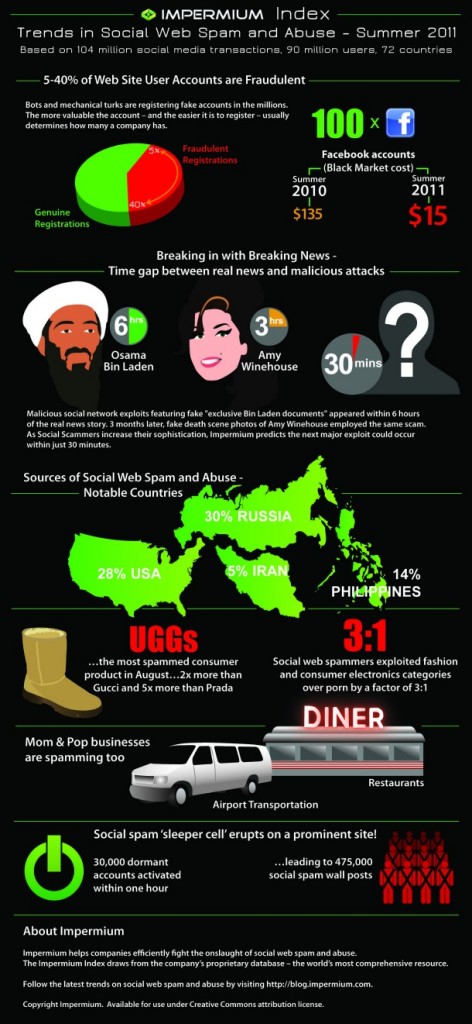Surprising Trends in Social Web Spam Attacks – Impermium Index
Social web spam and abuse on social media sites has been a cause of nuisance for the website owners. Social media is so open, that almost anyone can post anything about anyone, thereby posing a very high risk on brand reputation.
Impermium, a social web security company has come up with Impermium Index showing an indepth analysis on the types of severity of social web spam and abuse. According to the report, social media spam attacks are growing exponentially and simultaneously there is an increase in the sophistication to the tactics used by the spammers.
So here are the highlights of the first report, named – Summer 2011. The report is based on a large sample of almost 104 million social media transactions over a period of 100 days involving a user base of more than 90 million across 72 countries.
- Fraudulent Online ID Signups – Fake accounts range from a low 5 percent to almost 40 percent of users. Scammers
 are registering accounts in huge numbers (almost millions) as they send fake friend requests, fake tweets and so on. The black market for bulk social networking accounts is also growing exponentially. This is not surprising as you can see a lot of websites selling Facebook Fans and Twitter followers for big bucks. Obviously they do not have real fans or followers, they simply create 100’s and 1000’s of fake accounts and use them.
are registering accounts in huge numbers (almost millions) as they send fake friend requests, fake tweets and so on. The black market for bulk social networking accounts is also growing exponentially. This is not surprising as you can see a lot of websites selling Facebook Fans and Twitter followers for big bucks. Obviously they do not have real fans or followers, they simply create 100’s and 1000’s of fake accounts and use them. - Dormant Accounts are most vulnerable – Accounts that you created and have not been using much could be the next target for the spam attackers. Impermium helped one prominent social network from a coordinated attack by more than 30,000 fraudulent accounts, which got live in just 1 hour and attempted to submit more than 475,000 wall posts. But this is not just limited to dormant accounts, even the ones that are live since years could be hacked at the right moment.
- Spam Attack Techniques are More Better and Harmful – New and new techniques of attacking the social web with spam are coming up quickly. If there is a popular brand or a news event, the spammers exploit it to spam. Scammers use the most popular or emotional news to get increased clicks. For e.g. the recent news of Osama’s death or Amy Winehouse’s death, scammers used them to deceive users into clicking malicious links.
- Uggs was the #1 most exploited brand in the social web, followed by Gucci and Prada.
- Surprising, the top consumer categories in the social web spam space were fashion and electronics, which were above porno scams by 3x.
- SBU are scammers – The small businesses are getting more into social web spam. According to the report, small units like local restaurants, shuttle services, etc. which are hit by the recession, are resorting to the spam activities to make few more bucks.
It keeps getting difficult and difficult to fight the spam in the social web. The key is to be watchful and alert about what is being talked about your brand and where.
Pingback: Surprising Trends in Social Web Spam … – Future Digital Marketing · Digital Marketing in Small Bites